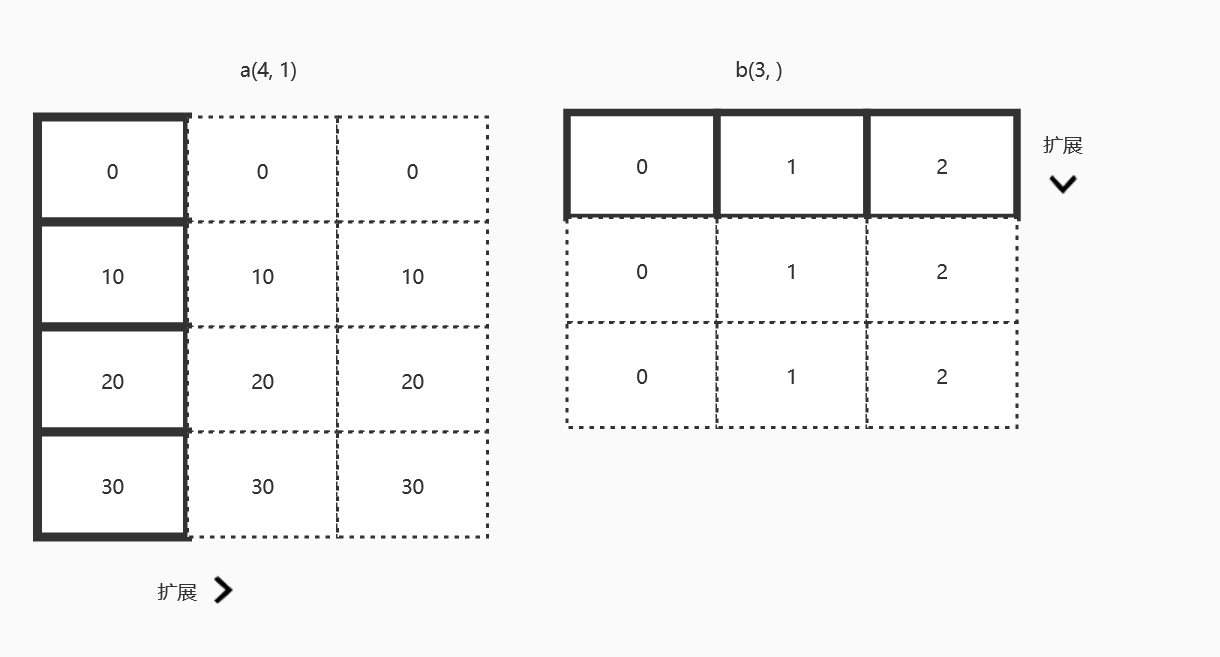NumPy 入门
NumPy
初识 NumPy
NumPy 的主要对象是同质多维数组,也就是在一个元素(通常是数字)表中,元素的类型都是相同的。其中可以通过正整数的元组来对元素进行索引。
在 NumPy 中,数组的维度被称为轴(axes),轴的数量被称为秩(rank)。例如在三维空间的一个点坐标[1,2,1],就是秩为1的数组,因为它只有一个轴。
NumPy 的数组称为 ndarray, 别名为 array。numpy。array 与 Python 标准库里的 array.array 不一样,标准库只能处理一维数组并且功能相对较少。
ndarray 对象属性
| 属性 | 含义 |
|---|---|
| T | 转置 |
| size | 数组的元素的个数 |
| itemsize | 每个元素的大小 |
| dtype | 数组元素的数据类型对象 |
| ndim | 数组的轴数量 |
| shape | 数组的维度 |
| Flat | 返回数组的一维迭代器 |
| imag | 返回数组的虚部 |
| real | 返回数组的实部 |
| nbytes | 数组中所有元素的字节长度 |
NumPy 数组类型
- int8, int16, int32, int64, uint8, uint16, uint32, uint64
- float16, float32, float64
- complex64, complex128
可以使用 dtype 来指定数据类型,也可以通过 astype()
>>>print(np.array(5, dtype=int32))
5
>>>print(np.array(5, astype(float)))
5.0
NumPy 创建数组
-
可以用 numpy.array 来将列表或元组转换为 ndarray 数组,可以通过 order= 来指定顺序
-
使用 arange(),和 range() 基本一样,可以指定 dtype 来设置返回的 ndarray 的类型
-
linspace() 生成等差数列
numpy.linspace(start, stop, num=50, endpoint=True, retstep=False, dtype=None)
endpoint 表示最后一个样本在不在序列内, retstep 为 True 时会返回间距
-
使用 logspace 生成等比数列
numpy.logspace(start, stop, num=50, endpoint=True, base=10.0, dtype=None)
base 表示基底,取对数时 log 的下标
-
ones, zeros 分别创建一个指定形状的全1数组和全0数组
索引和切片索引
和c中对多维数组的索引获取一个道理,不同的是其支持切片如a[0:2, 0:2], 含义是第1,2行的1,2列组成的2x2的矩阵
1 | import numpy as np |
切片一定得到的是一个列表
布尔型索引
布尔型索引又叫花式索引(Fancy indexing),指的是利用整数数组进行索引。布尔型的索引是基于布尔数据的索引,它也是利用特定的迭代器对象实现的
1 | import numpy as np |
同样的,布尔索引也支持别的运算符如大于号小于号等等
矩阵的合并与分割
矩阵的合并
hstack() 左右合并, vstack() 上下合并
也可以用 vstack((A, B)), hstack((A, B)) 来实现不同轴上的合并
1 | import numpy as np |
矩阵的分割
在数组的合并操作中,函数 column_stack() 支持列方向上的合并,但是在处理一维数组时,按列方向组合,结果为二维数。
当处理二维数组时和 hstack 方法一样。同样, row_stack() 支持行方向上的合并,在处理一维数组时按行方向组合,二维数组 vstack 方向一样。
1 | # 矩阵分割 |
矩阵运算与线性代数
求范数
np.linalg.norm(x, ord=None, axis=None, keepdims=False)
- x 表示要度量的向量
- ord 处理范数的种类
| ord= | 描述 | 公式 |
|---|---|---|
| ord=2 | 二范数 | |
| ord=1 | 一范数 | $\sum_{i=1}^{n} \left| x_{i}\right| $ |
| ord=np.inf | 无穷范数 |
求矩阵的逆
1 | import numpy as np |
注意: 该矩阵必须可逆,否则抛出 LinAlgError 异常
不可逆的情况: |A| = 0
求方程组的解
1 | import numpy as np |
计算矩阵行列式
1 | import numpy as np |
最小二乘求线性函数
numpy.linalg.lstsq(array_A, array_B)[0]
1 | import numpy as np |
求特征值和特征向量
在 numpy.linalg 模块中,eigvals 函数可以计算矩阵的特征值(eigenvalue),而 eig 函数可以返回一个包含特征值和对应的特征向量(eigenvector)的元组
1 | import numpy as np |
奇异值分解
奇异值分解(Singular Value Decomposition, SVD)是一种因子分解运算,将一个矩阵分解为3个矩阵的乘积。
U, Sigma, V = np.linalg.svd(D)
结果是两个正交矩阵UV, 以及中间的奇异值矩阵
NumPy 的广播机制
广播(Broadcasting) 是一种维度处理原则,广播操作会使程序更加简洁高效。
广播原则:如果两个数组的后缘维度(即从末尾开始算起的维度)的轴长相符或其中一方的长度为1,则认为它们是广播兼容的,
广播会在缺失或长度为1的轴上进行。当我们使用函数计算时,函数会先对两个数组的对应元素进行计算,因此要求两个数组具有相同的大小,
如果不同,为了避免多重循环,会进行如下广播处理:
- 让所有的输入数组都向维度最长的数组看齐,维度不足的部分通过在前面加1补齐
- 输出数组的维度是输入数组维度的各个轴上的最大值
- 如果输入数组的某个轴和输出数组的对应轴的长度相同或者都为1时,这个数组能够用来计算,否则出错
- 如果输入数组的某个轴的长度为1时,沿着此轴运算时都用此轴上的第一组值
- 如果任何一个维度是1,那么另一个不为1的维度将被用作最终结果的维度。也就是说为1的维度将延展到与另一个维度匹配。
1 | import numpy as np |
广播补全可以参考下图

numpy 统计函数
- 用的时候可以再查
最大最小
1 | import numpy as np |
极差
- numpy.ptp(ndarray[, axis=]) 可以用 axis 指定行或列轴, axis=0 为列轴
均值方差
1 | import numpy as np |
NumPy 排序,搜索
-
numpy.sort
可以指定 axis = None, 0, 1 来指定排序方法, None 会将结果折叠为一维数组,0会按列处理, 默认为1,按行处理
1 | import numpy as np |
-
numpy.argsort
对 a 排序,a 不变,返回一个排序后的索引,其余和 sort 相同 -
numpy.lexsort
支持对数组按指定行或列的顺序来排序,是间接排序
1 | import numpy as np |
- argmax, nargmax
如果不指定 axis 则返回平坦化的下标,指定会按指定列或行轴来返回最值下标
